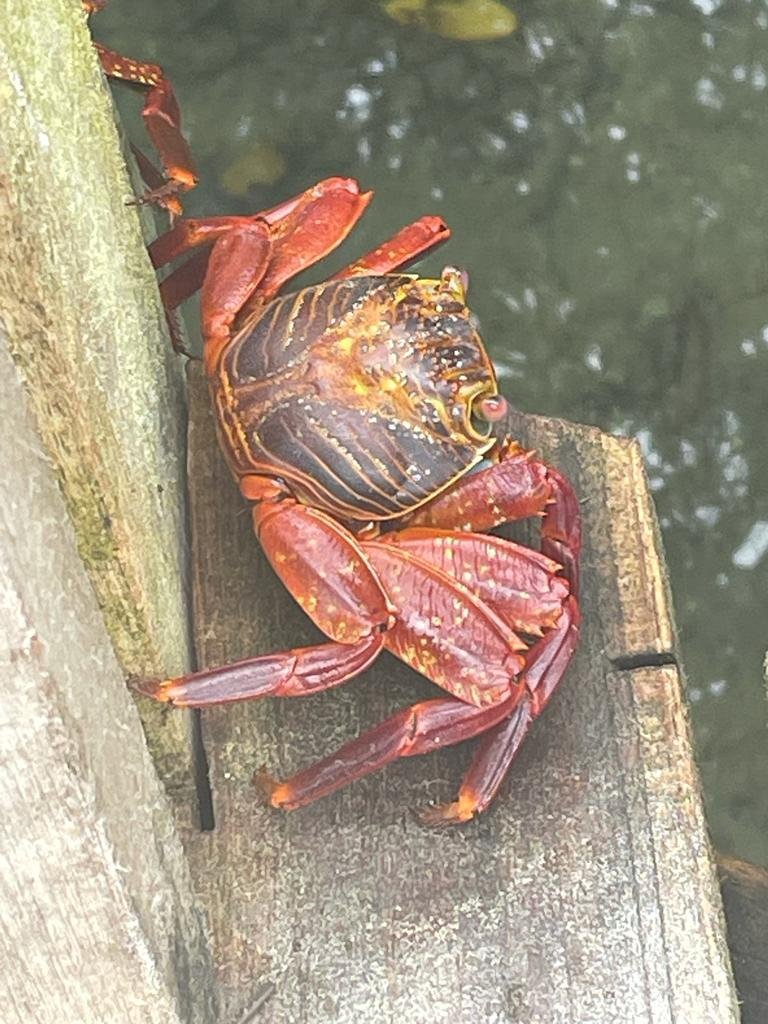Isla Isabela
Friday 27 May - we arrived in Puerto Villamil just in time for a sunset drink and to plan our following day. Isla Isabela is the most western island of the 3 Galápagos Islands and is home to 5 active volanoes, it is also the last of our stops here before we depart for French Polynesia.
Saturday 28 May – Geoff and I took a water taxi to the port and hired a couple of bikes so we could get around and see the town and special sights at our leisure. First stop was a tasty breakfast in the town, which was surprisingly quiet and had a distinct lack of cars. It is quite different from Santa Cruz and San Cristóbal – with a more laid back vibe and far less touristy.
First we cycled to Poza de las Diablas to see the famous flamingoes in their natural habitat. The Galápagos flamingo is nicknamed the Rosy Flamingo as most of their plumage is bright pink in contrast to the paler Europen and African species, this pink colouring comes from their diet. They feed on small crustaceans and tiny water plants and their distinctive crooked beaks are pink with a black tip, and are used to separate mud and silt from their food. An interesting fact: flamingoes only eat with their heads upside down. Their beaks have thin, flat membranes known as lameliae that act as filters for food. Unfortunately for us, the trip proved slightly disappointing as they were all at the furthest end of the lake and we could hardly see them! The good news though is that in another lagoon nearer town, I saw a lovely flamingo on our walk to the restaurant for dinner!
Next stop was the Galápagos Breeding Centre, even thought we had already had a tour of a private farm with tortoises in Isla Cristóbal, we learned some different facts from this Centre. As well as the species of tortoises from the Sierra Negra volcano, there is a another species peculiar to Isla Isabela. This species was rescued from an eruption of the Cerro Azul Volcano in 1998. Their shells are squashed down unlike any other tortoises living in Galápagos, the bottom shell of the male is more concave which facilitates mating. Fortunately all the males are sexually active and the females are quite fertile and there have already been 220 new tortoises of this species. And talking of sexually active…..we were able to see two pairs of tortoises mating – it was quite the spectacle! One pair were right in front of us over the fence and it was interesting to note that the male had pushed the female against a tree so she couldn’t move and was straining his head and neck and grunting on top of her making a very interesting noise! Apparently their “sessions” go on for about 5 hours! Now that’s an interesting fact! They mate every year, but only start after they are 30 years old, and the female lays between 10 and 14 eggs. Once laid she digs a hole using her hind legs, and deposits the eggs and then defecates and urinates on them to moisten the ground and cover them. Then that’s it - she just abandons them! The newborns have nothing to eat or drink inside the nest but survive thanks to food reserves inside their bodies. The Centre has about 900 newborn tortoises per year and releases around 10 of the older tortoises into the wild each year too.
Next stop – and a good biking workout of 5 kms on a rough sometimes gravel, sometimes sand - dodging iguanas and the odd tortoise - on the path was “El Muro de Las Lágrimas’ – The Wall of Tears. An ugly and pointless wall made of sharp volcanic slag and standing as a monument to the political prisoners and common delinquents who were housed in the Isabela Penitentiary Colony between 1946 and 1959. The prisoners had to chisel heavy, irregular pieces of volcanic rock from a quarry a long walk away, then lug the sharp stones back to the site to build the wall – a form of hard labour as a punishment. It reaches up to 65 feet high and is over 300 feel long. It was dangerous work, resulting in the death of a number of them. Locals say that if you listen closely to the wall you can hear the cries of the spirits of long-dead prisoners…
We finished our day with a mango mojito at a beach bar and a lovely dinner at the end of a wharf over looking the Pacific feeling very satisfied that we had seen everything on our list and had had some great exercise on the bikes in doing so!
Sunday 29 May – a red letter day. We are leaving for French Polynesia around 4pm this afternoon. So dear friends, there will be no blogs from me for around 14 days whilst we sail there.
Check in around 11 June for more updates.
Bye bye for now!

















